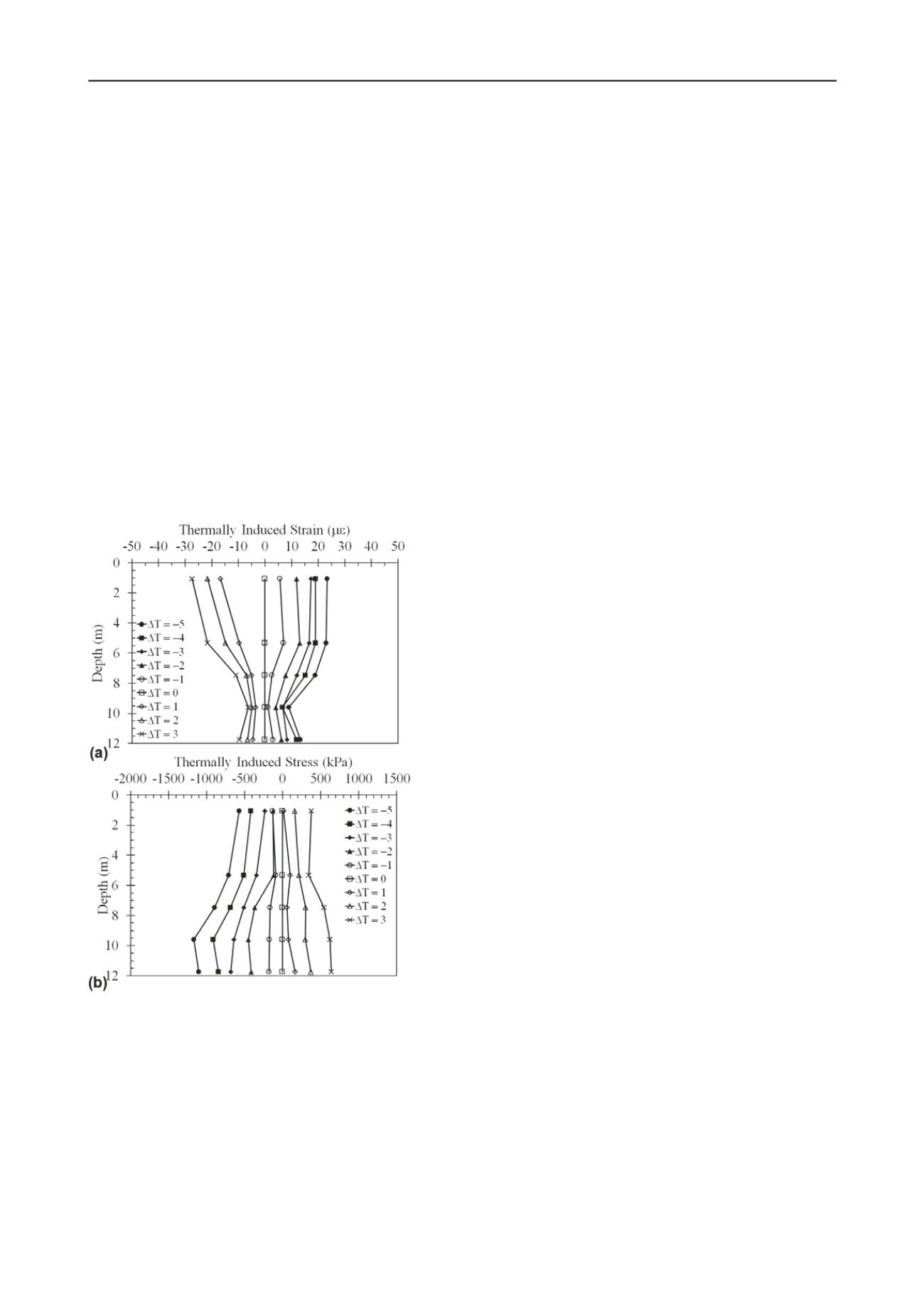
3382
Proceedings of the 18
th
International Conference on Soil Mechanics and Geotechnical Engineering, Paris 2013
scale foundation, the greatest strains were noted near the top of
the foundation, resulting from the end-bearing boundary
conditions at the toe. It was not possible to measure the
displacement at the top of the foundation, but integration of the
strains indicates that an upward displacement of approximately
0.18 mm occurred during a change in temperature of 3
°
C.
Although the strain at the top of the foundation during heating is
close to that expected for free expansion, this is not the case
during cooling, where the strains are about 50% of free
expansion conditions. During cooling of the foundation (heating
of the building), the smaller axial strains are possibly due to the
reinforcement connection to the grade beams at the ground
surface. This indicates that K
h
may be different for heating and
cooling. The thermal axial stresses calculated using Equation 1
are shown in Figure 5(b). The coefficient of thermal expansion
for the reinforced concrete was not measured, but is assumed to
be -10
/
°
C for the concrete mix design used in Colorado
(Quartz aggregate with high slump). Similar to the centrifuge-
scale energy foundation, the maximum stress is located near the
toe of the foundation. In contrast to the results in Figure 4(b),
the trend of the axial stresses indicates that the stresses do not
tend toward zero at the top of the foundation. Based on the
magnitude of stresses during heating, it is possible that the value
of K
h
is approximately half the stiffness of the end bearing
spring at the toe of the foundation.
Figure 5.Full-scale results: (a) Axial strains; (b) Axial stresses
5 CONCLUSIONS
The results presented in this study indicate that the head
boundary conditions of energy foundations have an important
effect on the magnitude and shape of stress distributions in
energy foundations. The results from an end-bearing centrifuge-
scale foudation heated in load-controlled conditions indicate a
similar shape to the thermal stress distribution but with
negligible stresses at the head of the foundation. The results
from a full-scale, end-bearing energy foundations during typical
operation of a building in Denver, Colorado indicate that the
thermal stresses are the greatest near the toe of the foundation,
although the stresses near the head of the foundation are non-
zero. The results indicate that even though a building applies a
constant load to an energy foundation, the grade beam
connections provide constraint to the head of an energy
foundation, potentially with different magnitudes depending on
whether the foundation is being heated or cooled.This is a
subject of continued research being evaluated through further
comparison of centrifuge- and field-scale foundations.
6 ACKNOWLEDGEMENTS
Financial support from the National Science Foundation grant
CMMI 0928159 is appreciated.The authors acknowledge the
support of Milender-White Construction Company, KL&A
Structural Engineers, AMI Mechanical, Rocky Mountain
Geothermal, and the Denver Housing Authority for agreeing to
incorporate the energy foundations into the building.
7 REFERENCES (TNR 8)
Adam, D. and Markiewicz, R. (2009). “Energy from Earth-Coupled
Structures, Foundations, Tunnels and Sewers.” Géotechnique.
59(3), 229–236.
Amatya, B.L., Soga, K., Bourne-Webb, P.J., Amis, T. and Laloui, L.
(2012). “Thermo-mechanical Behaviour of Energy Piles.”
Géotechnique. 62(6), 503–519.
Bourne-Webb, P., Amatya, B., Soga, K., Amis, T., Davidson, C. and
Payne, P. (2009). “Energy Pile Test at Lambeth College, London:
Geotechnical and Thermodynamic Aspects of Pile Response to
Heat Cycles.” Géotechnique 59(3), 237–248.
Brandl, H. (2006). “Energy Foundations and other Energy Ground
Structures.” Géotechnique. 56(2), 81-122.
Hughes, P.J. (2008). Geothermal (Ground-Source) Heat Pumps: Market
Status, Barriers to Adoption, and Actions to Overcome Barriers.
Oak Ridge Nat. Lab. Report ORNL-2008/232.
Knellwolf, C. Peron, H., and Laloui, L. (2011). “Geotechnical Analysis
of Heat Exchanger Piles.” ASCE Journal of Geotech. and Geoen.
Eng. 137(10). 890-902.
Laloui, L., Nuth, M., and Vulliet, L. (2006). “Experimental and
Numerical Investigations of the Behaviour of a Heat Exchanger
Pile.” International Journal of Numerical and Analytical Methods in
Geomechanics. 30, 763–781.
McCartney, J.S., Rosenberg, J.E., and Sultanova, A. (2010).
“Engineering Performance of Thermo-Active Foundation Systems.
ASCE Geotechnical Practice Publication 6. pg. 27-42.
McCartney, J.S. and Rosenberg, J.E. (2011). “Impact of Heat Exchange
on the Axial Capacity of Thermo-Active Foundations.”
GeoFrontiers 2011. Dallas, TX. 10 pg.
McCartney, J.S. and Stewart, M.A. “Centrifuge Modeling of Energy
Foundations under Cyclic Heating and Cooling.” ASCE Journal of
Geotechnical and Geoenvironmental Engineering. In review.
McCartney, J.S. and Murphy, K. (2012). “Strain Distributions in Full-
Scale Energy Foundations.” DFI Journal. In review.
McCartney, J.S. (2011). “Engineering Performance of Energy
Foundations.” 2011 PanAm CGS Geotechnical Conference.
Toronto, Canada. October 2-6, 2011. 14 pg.
Ozudogru, T., Brettmann, T., Olgun, G., Martin, J., and Senol, A.
(2012). “Thermal Conductivity Testing of Energy Piles: Field
Testing and Numerical Modeling.” ASCE GeoCongress 2012.
Oakland, CA. March 25-29th 2012. 10 pg. CD ROM.
Plaseied, N. (2011). Load-Transfer Analysis of Energy Foundations.
M.S. Thesis. University of Colorado Boulder. 90 pg.
Stewart, M. (2012). Centrifuge Modeling of Strain Distributions in
Energy Foundations. MS Thesis. U. of Colorado Boulder. 110 pg.
Wood, C.J., Liu, H. and Riffat, S.B. (2009). “Use of Energy Piles in a
Residential Building, and Effects on Ground Temperature and Heat
Pump Efficiency.” Géotechnique 59(3), 287–290.


